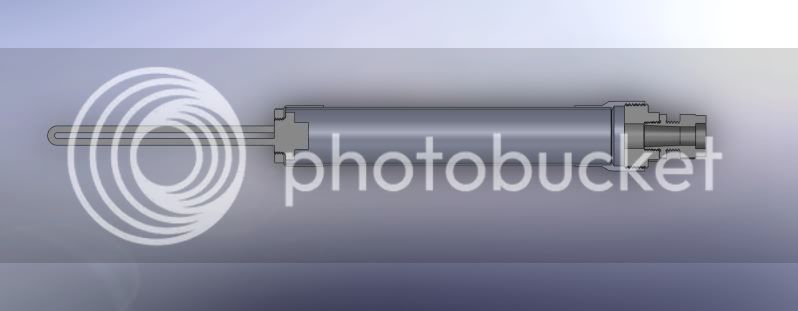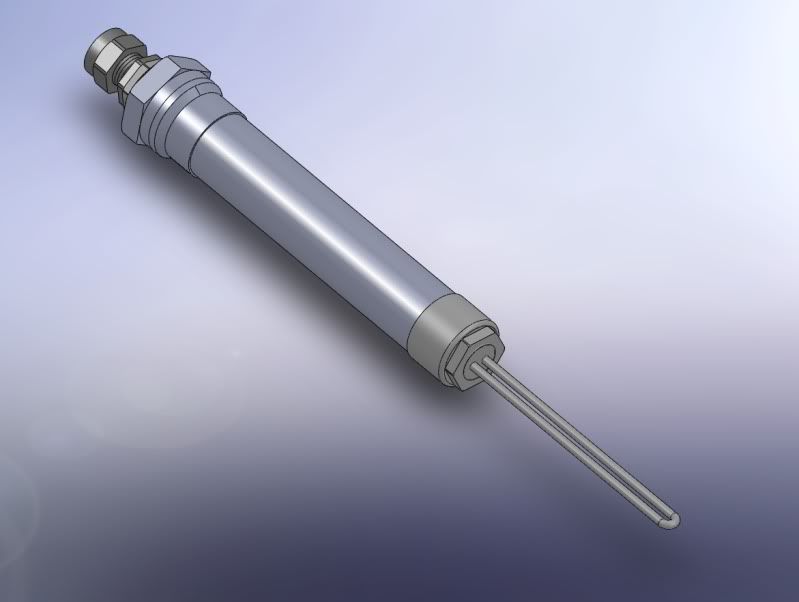klyph
Well-Known Member
Trying to design a heatstick that is all metal, water tight and able to be disassembled for maintenance. I modeled this then realized tri-clamps would be cheaper/easier/simpler, so I'm working on the tri-clamp version.







wouldnt all metal get hot!!?? assuming you would have a part of the handle in the hot water.
Interested to see the triclamp design. Just keep cost/practicality in mind.
The cost of the current design is about $100.
The goal is to create a better heatstick than the drain pipe/plumber's putty for a minimal added cost, so any other critiques or ideas are welcome.

What do you consider "better"?
What are the design goals?
What makes the drain pipe/JB Weld design inferior?
How much of a cost adder are you looking for (5%, 10%, etc)?
sorry for the 20 questions, but I'm just curious.
BTW, are you using Solidworks?
Here is my parts list to build two of these:What materials are you using,
http://www.mcmaster.com/#copper-pipe-caps/=6rci22 - 2" copper pipe caps - $5.22 x2 = $10.44
http://www.mcmaster.com/#brass-pipe-fittings-and-pipe/=6rckze - 1" Brass Locknut - $5.09 x2 = $10.18
http://www.mcmaster.com/#copper-tube-to-pipe-adapters/=6rcn99 - 2" Copper tube to Pipe adapter - $16.01 x2 = $32.02
http://www.mcmaster.com/#brass-pipe-fittings-and-pipe/=6rcp35 - 2" to 3/4" Brass bushing - $19.29 x2 = $38.58
http://www.mcmaster.com/#cord-grips/=6rcpvw - Liquid tight Strain Relief - $17.21 x2 = $34.42
http://www.mcmaster.com/#copper-tubing/=6rcsrs - 24"x2" Copper tubing - $37.37 (may need longer piece depends on element length)
http://www.mcmaster.com/#electrical-wire-cable-and-cords/=6rcvc5 - 12/3 Service Cord - $1.03 x16 - $16.48
http://www.mcmaster.com/#nema-plugs-connectors-and-receptacles/=6rczmn - Male Plug - $7.03 x2 - $14.06
http://www.amazon.com/dp/B0006JLVBW/?tag=skimlinks_replacement-20 - Camco 2000w Element - $11.05 x2 = $22.10
TOTAL = $215.65
It's a 2" copper cap with a 1.25" hole drilled into it and a 1" locknut on the outside. the cap would be soldered to the tube, but the element can be removed by taking off the locknut.and what fitting is it that you have that holds the water heater element in the pipe? Is it something special?
It's a 2" copper cap with a 1.25" hole drilled into it and a 1" locknut on the outside. the cap would be soldered to the tube, but the element can be removed by taking off the locknut.
24"x2" Copper tubing - $37.37 (may need longer piece depends on element length)
EXCELLENT idea!
The only problem is the element can only be removed through the back, that's why the unit is 2" all the way up. Tri-clamps would solve this issue.
be careful with those locknuts. heater elements have straight threads (NPS), and plumbing fittings have tapered threads (NPT). I'd be a little nervous about leaks through the threads going right into where your wiring is.
bargainfittings sells 1" stainless NPS locknuts w/ o-rings for $9 specifically meant for heater element applications... might be worth considering.
Well... you could use 1/2" tubing most of the way down the handle (just big enough for your cord) and then expand out from there with male and female threaded 2" parts.
You would be able to unscrew it near the bottom then where it is 2" and get at the element.
but that might be more expensive. The threaded copper parts might be expensive at 2" diameter.
What do you consider "better"?
What are the design goals?
What makes the drain pipe/JB Weld design inferior?
How much of a cost adder are you looking for (5%, 10%, etc)?
sorry for the 20 questions, but I'm just curious.
BTW, are you using Solidworks?
Yes, I used NPS locknuts in the design. and the stock element gasket will seal on the inside, so I've never understood why the oring on the outside is necessary. Seems it would just add more flex.
Would there be any concern with it being all metal in the event of a wiring/element failure?
I don't know for sure but, I think having a non-conducting handle would be a good idea.
Greydog

I like this discussion and brainstorming...food for thought...what i like to do, and I believe I started doing this when I accidentally brought home 1 1/14 pipe rather than 1 1/2" pipe, is to grind down the hex nut that is part of the element so the overall housing can be substantially reduced. Going w/ 2" seems large to me? The dia. of the element base nut can be reduced pretty easily,. just leave a slight shoulder for the gasket.
I had the same idea recently. I decided to go with an elbow. I'm documenting my progress in this thread.

-Joe
You know, you may be right, I think the hex on my element is larger than reality. I based it on a 1" locknut, but now that you mention it, a 1.5" pipe will probably work.

I just went through the same exercise with heatsticks for an upcoming Basic Brewing Radio though I didn't go this far. I did manage to get one sealed up water-tight with a 1.5 to 1.25 compression reducer but after a couple of heat cycles, the reducer started working itself loose. I eventually conceded that potting the element wiring in epoxy really is best.
Ultimately, heatsticks are a bit of false economy IMO. The plumbing bits end up running about $20 - $25 and you still need a pot. May as well mount the element directly in your pot. $20 28-32qt aluminum pots are trivial to find too. I also found managing heatsticks took extra mental care not to dry-fire and they pose a greater tip-over risk with the cord hanging out the top of a pot.
Enter your email address to join: